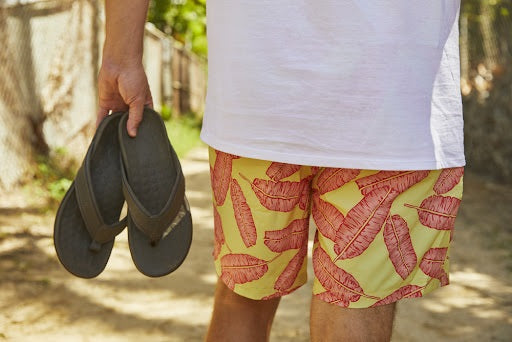Slippers For Plantar Fasciitis: How To Pick The Perfect Pair
Plantar fasciitis can be a challenging foot condition to deal with as it is distinguished by the heel pain caused by inflammation. Doing normal activities can trigger symptoms of plantar fasciitis and be easily worsened by physical activity that involves impact on the feet which can intensify the heel pain. One of the first steps that are often recommended to individuals suffering from plantar fasciitis is to make sure that all shoes are properly supporting the feet. While orthotic insoles in athletic shoes are common, many individuals overlook their other types of footwear that lack the support they need to keep the symptoms of plantar fasciitis at bay. One of the most common types of overlooked footwear is slippers. House shoes are a cozy and comfortable choice of footwear, but unfortunately, many slippers are not designed with the supportive infrastructure needed for those suffering from plantar fasciitis. If you are suffering from plantar fasciitis, it is important to research not just orthotic insoles, but orthotic slippers for plantar fasciitis in order to find the right slippers for plantar fasciitis. When looking for the right orthotic slippers, plantar fasciitis causes and triggers should be kept at the forefront of your mind and used to inform your search. To help you even further to find the right orthotic slippers, plantar fasciitis must be fully understood. To help make your search simple and easy we have put together a guide on what plantar fasciitis is, common causes, and how to find the perfect pair of slippers to support plantar fasciitis.
What is Plantar Fasciitis?
Before delving into how to find the right slipper for plantar fasciitis, it is important to understand what plantar fasciitis is and how it affects the feet. Plantar fasciitis is a foot condition that is one of the most common causes of heel pain. Plantar fasciitis occurs when the plantar fascia, a thick fibrous band of tissue that runs across the bottom the foot and connects the heel bone to the toes, becomes inflamed. This band of thick fibrous tissue helps to support the muscles, toes, and arch of the foot. When the plantar fascia is stretched too much, tiny tears develop on the surface resulting in the plantar fascia becoming inflamed and causing pain. It was once thought that plantar fasciitis developed as a result of heel spurs, which are bony growths that can form on the heel. However, over time this suspicion shifted. Now it is believed that heel spurs are a result of extended inflammation of the plantar fascia, making them a result of plantar fasciitis rather than a cause. With this understanding of plantar fasciitis in mind, it is important to understand the symptoms, causes, risk factors, and potential impact of this condition.
Common Symptoms of Plantar Fasciitis
Plantar fasciitis pain is often characterized by sharp, stabbing pains in the bottom and/or heel of the foot. Individuals suffering from plantar fasciitis often experience this pain most acutely when they first begin walking after waking up. However, plantar fasciitis pain can occur at any time, particularly after rising from sitting. Plantar fasciitis pain can be exacerbated by additional strain and inflammation due to exercise. However, this pain often occurs and worsens after exercise and not during the exercise itself. In addition to stabbing pain, plantar fasciitis may also cause the heel of the foot to be tender to the touch.
Common Causes of Plantar Fasciitis
While many people don’t think about the role of the plantar fascia, it plays a vital role in everyday movements. The plantar fascia acts as a shock absorption that supports the heel bone and arch of the foot. This is how the foot copes with the impact and pressure of everyday life and movements. However, when the plantar fascia becomes stressed and experiences increased tension, small tears can begin to develop on its surface. If the plantar fascia continues to be stretched and torn over time, the plantar fascia can become increasingly irritated and inflamed. What causes plantar fasciitis to develop is determined on a case-by-case basis and can vary from person to person. There are a number of risk factors for developing plantar fasciitis that can contribute to its onset.
Risk Factors for Plantar Fasciitis
There are a number of risk factors for developing plantar fasciitis that it is important to be aware of. Below are a handful of the most common risk factors for developing plantar fasciitis.
- Foot Mechanics: One of the most common risk factors for plantar fasciitis is the mechanics of the feet. Individuals with high arches or flat feet/low arches are much more likely to develop plantar fasciitis due to the feet being biomechanically imbalanced. This biomechanical imbalance causes the feet the to under-pronate (for those with high arches) or over-pronate (for those with flat feet/low arches). In addition to arch height, individuals with an abnormal pattern of walking are also more at risk to develop plantar fasciitis.
- Age: Plantar fasciitis is more common in individuals between the ages of forty to sixty years of age.
- Obesity: Excess weight on the body can put an increased amount of stress on the plantar fascia, which can result in plantar fasciitis.
- Exercise: Individuals who engage in high impact exercises that place a high amount of stress on the heel and attached tissue are more at risk for developing plantar fasciitis. Activities such as running, aerobic dance, circuit training, and ballet are examples of exercises that increase the risk of developing plantar fasciitis.
- Occupation: Jobs that require individuals to spend the majority of their work hours standing or walking on hard surfaces, such as teachers, are more at risk for developing plantar fasciitis.
With this understanding of plantar fasciitis in mind, it is now easier to make an educated decision when deciding on a pair of slippers that are ideally suited to those suffering from plantar fasciitis.
How to Pick the Perfect Pair of Slippers for Plantar Fasciitis
Picking the perfect pair of slippers for plantar fasciitis can seem like a challenge, but once you have the right knowledge and tips, selecting the right pair of slippers for you is a breeze. To help you pick the perfect pair of slippers, we have put together a guide to choosing the right slippers for plantar fasciitis. Below are the key features to look for when selecting the perfect pair of slippers for this particular condition.
- Arch Support: When looking for slippers for plantar fasciitis, the most essential aspect of your selection should be identifying slippers that provide arch support. Individuals with a low arch/flat feet have a very flexible foot with the arch of the foot sitting very close to the ground. Because of this, individuals with low arches are prone to over-pronation, which occurs when the foot rotates too far inward with each step. This makes individuals with low arches prone to developing plantar fasciitis. Conversely, individuals with high arches have a very rigid foot structure that is more susceptible to underpronate, this means that the foot rolls outward too far. Due to this fact, individuals with high arches are also more likely to develop plantar fasciitis. Finding a slipper with proper arch support is essential to help individuals prevent plantar fasciitis and also those currently suffering from plantar fasciitis.
- Sole Cushioning: The key to finding the right pair of slippers is comfort. For individuals suffering from plantar fasciitis, sole cushioning is extremely important as it will help to ease the pain that may be felt in the heel. When looking for the perfect pair of slipper for plantar fasciitis, be sure to look for proper sole cushioning.
- High-Quality Materials: Finding the right pair of slippers also means looking for slippers that are designed using high-quality materials. You do not want a pair of slippers that is going to deteriorate quickly as they will lose their structure and will no longer provide the necessary support to the feet. Instead, look for slippers that are made using high-quality materials that are durable and made to last.
- Stylish Design: If you are going to purchase a pair of slippers for plantar fasciitis, it is essential that you want wear them. Many orthotic slippers and footwear are not designed with style in mind, which means that though they offer the best support, they are not always appealing to wear. To make sure that you wear your slippers so they can provide your feet with the support they need, it is important that you select a pair of slippers that have a stylish design that fits your personal aesthetic. Slippers do not need to sacrifice style to be supportive; they can do both.
With these features in mind, you can choose the right pair of slippers for plantar fasciitis to help your feet get the support and comfort they need while not having to give up your personal style.
The Benefits of Supportive Slippers
Once you have found the right pair of supportive slippers for plantar fasciitis, you will experience many remarkable benefits. Below are a handful of the top benefits of having supportive slippers for plantar fasciitis.
- They Offer Unparalleled Comfort: When thinking of slippers, one of the first things that come to mind is the comfort. Slippers are meant to provide your feet with a warm and cozy environment so that they remain comfortable even when the temperatures begin to drop. One aspect of comfort in footwear that is often overlooked is having footwear that provides the right arch support to the foot. When your foot does not receive the arch support it needs, it can result in pain and discomfort, in addition to exacerbating any existing foot conditions. By investing in slippers that are made with soft, high-quality materials and built-in supportive infrastructure, you will be able to experience unparalleled comfort.
- They Can Help to Ease The Symptoms of Plantar Fasciitis: The primary symptom of plantar fasciitis is stabbing heel pain, particularly during the first few steps of the day. When your foot is properly supported, it can help to offset tension to the plantar fascia, thereby reducing the pain and discomfort associated with plantar fasciitis. Instead of your foot continuing to stretch and tear the plantar fascia, it is properly supported and can move about more comfortably. Support slippers can help your feet to have the reinforcement they need to help ease the symptoms of plantar fasciitis.
- They Can Help to Increase Blood Flow: One of the lesser known benefits of supportive slippers is that they help to keep the feet, ankles, and legs in proper alignment, which helps to promote blood flow to the lower extremities. This increase in blood flow can help reduce swelling in the feet and ankles that is often uncomfortable and hinders ease of mobility. In addition, this increase of blood flow to the area helps make sure the area is receiving the amount of blood it needs to function properly. Supportive slippers help to make sure blood flow to the feet and ankles is boosted, which is ideal for those suffering from health conditions, like plantar fasciitis, that can cause swelling in the lower extremities.
If you are looking for the right pair of slippers for plantar fasciitis, it is important to find a company that specializes in supportive footwear. Vionic’s slippers rely on science-backed innovative roots for their unique biomechanic design that provides optimal support to the foot. Vionic’s slippers, that harness pioneering biomechanics technology and high-quality materials, produce beautifully made slippers that combine leading technology with fashion-forward style. With Vionic slippers, no corners are cut. Utilizing sophisticated and elegant designs Vionic slippers allow you to live stylishly and confidently while also making sure your feet receive the support they need.




